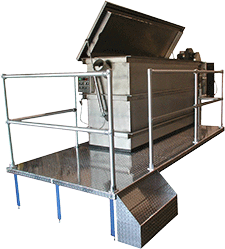- 01: Introduction
- 02: History
- 03: Propellants, Firearms, and Ammunition Development
- 04: Modern Firearms Manufacture
- 05: Small Arms Ammunition
- 06: Evidence Handling Procedures
- 07: Equipment and Instrumentation
- Introduction
- Objectives
- AFTE Knowledge and Ability Factors
- Measurement, Standards, and Accuracy
- Weight, Force, and Their Measurement
- Dimensional Data and Measurement Tools
- Muzzle Velocity of Bullets
- Stereo and Comparison Microscopes
- Small Tools and Supplies
- Imaging Equipment
- Field Support Equipment
- Computer-Based Technologies
- Firing Facilities
- Selected Bibliography
- 08: Examination of Firearms
- 09: Cartridge and Shotshell Examination
- 10: Characterization and Evaluation of Fired Projectiles
- 11: Bullet Comparison and Identification
- 12: Gunshot Residue and Distance Determination
- 13: Toolmark Identification
- 14: Communicating Results
- Resources


Water Recovery Tank
Home > Equipment and Instrumentation > Firing Facilities > Bullet Recovery Equipment > Water Recovery Tank

Water recovery tank
Click for larger imageInitially, water recovery tanks were fabricated locally. The tanks were typically oriented horizontally and measured approximately ten feet long and five feet high. Water filled the tank to just below the firing port. The firing port was angled to facilitate shooting diagonally from the top edge of one end of the tank to the bottom of the opposite end. Indoor vertical tanks are generally not used as they are impractical.
The following points should be considered when constructing a horizontal water tank:
- The angle of the fired bullet should be approximately 30° to
- avoid ricochets off the surface of the water,
- minimize damage to the bullet.
- The bullet should travel a minimum of ten to twelve feet on the diagonal in order to decelerate most fired bullets.
- The tank should be positioned to facilitate firing at a 30 degree angle while allowing the shooter to maintain a comfortable shooting position.
- Tanks, which can weigh as much as five tons, should be located on the building’s ground level.

Click here to watch a video of a .45 bullet entering a water recovery tank. Video courtesy of Mike Haag.
Since the mid 1980s, commercial bullet recovery tanks have become available and have been found to be the optimum method for bullet recovery. The features of commercially available tanks may include the following:
- Stainless steel construction
- Underwater lighting to avoid surface reflection
- Water filtration and purification
- Air-tight lid and exhaust system
- Assisted lifting system to open the lid
- Nonskid shooting platform
- Secure drain system to preclude bullet loss
- Light colored interior finish to improve visibility
- Convenient work surface on shooting platform
- Connection to a floor drain
The space allocated for bullet recovery must address the same requirements as any other shooting facility, to include the following concerns:
- Adequate ventilation
- Sound mitigation
- A means for lead removal from bullet traps
- Periodic removal of accumulated surface lead from walls, ceilings, and floors
- A posted emergency plan for range users
- First aid equipment
- Periodic training of all personnel in first aid with special emphasis on gunshot wounds
- Periodic training of all personnel in mouth-to-mouth resuscitation
- Landlines to emergency response personnel and managers
- Baseline and periodic testing for lead levels in the blood for all personnel
- Baseline and periodic hearing tests for all personnel
- Availability of eye and hearing protection in the space




